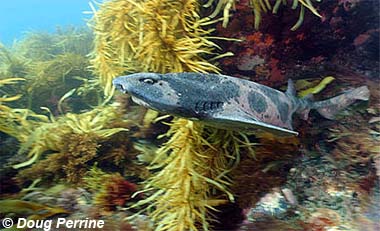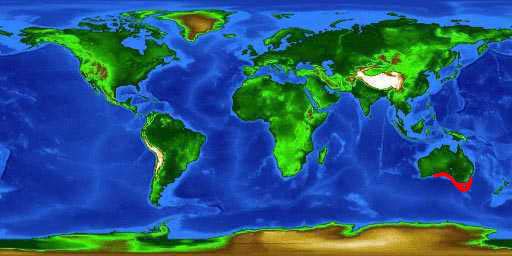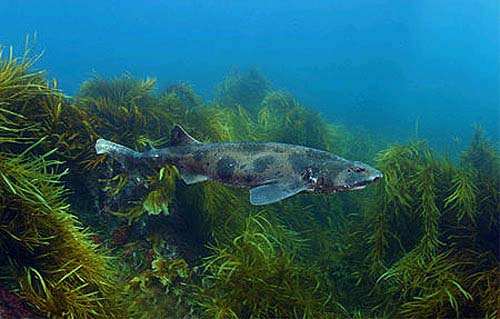Australian Swellshark

Cephaloscyllium laticeps
This thick, stout shark is recognizable for its medium-brown body covered in irregular darker blotches and spots, and their elongated, cat-like eyes. It is nocturnal and sedentary, and when threatened, can suck air and water into its body to inflate itself and look bigger. From blunt, broad snout, to asymmetrical caudal (tail) fin, they are usually around 3.3 feet long but can grow to almost five feet long. They prefer the continental shelf zones of southern Australia where they can easily hunt small reef fish and crustaceans.
Order: Carcharhiniformes
Family: Scyliorhinidae
Genus: Cephaloscyllium
Species: laticeps
Common Names
English language common names include Australian swellshark, Australian swell shark, draughtboard shark, flopguts, Isabell’s swellshark, nutcracker shark, rock shark, sleepy joe, swell shark, and whitefinned swellshark. Other common names are Australische zwelhaai (Dutch), Australsk ballonhaj (Danish), holbiche gressouillette (French), holbiche isabelle (French), pejegato australiano (Spanish), pejegato bordeado (Spanish), and Žralok nafukovací beloploutvý (Czech).
Importance to Humans
Australian swellsharks forms a large component of the southeastern Australian shark gill net fishery. However, this species is often released due to its limited commercial value. Post-release mortality is probably low as it is extremely resilient and survives out of water for consider lengths of time. Bottom trawlers also actively commercially fish for this shark.
Danger to Humans
Catsharks, including the Australian swellshark, are considered harmless to humans. If disturbed, it will inflate its stomach with air or water as a response to avoid predation. Lobster fishermen in some regions of Australia consider this species a nuisance when it enters lobster traps in search of food.
Conservation
Due to the lack of interest within the well-managed shark fishery off southeastern Australia, the Australian swellshark appears to be of low risk throughout its range in regards to conservation concerns. The World Conservation Union (IUCN) considers this species to be of “Least Concern” which means it does not qualify for “Critically Endangered”, “Endangered”, “Vulnerable”, or “Near Threatened” classifications.
> Check the status of the Australian swellshark at the IUCN website.
Geographical Distribution

The Australian swellshark is endemic to Australia. It lives from southeastern Western Australia to the central coast of New South Wales including Tasmania and Victoria.
Habitat
This unusual benthic shark lives along the continental shelf from shallow inshore waters out to depths of at least 2,133 feet (650m).
Biology
The head of the Australian swellshark is short and broad. The eyes are elongated and cat-like, situated high on the head. This species, as with all members of Scyliorhinidae, possess rudimentary nictitating lower eyelids. The anterior nasal flaps are subtrianbular and do not overlap the mouth posteriorly. There are no labial furrows on this shark. The body is robust and stocky with an inflatable stomach from which it receives its common name “swellshark”. Two dorsal fins are present, the second of which is located close to the caudal fin and is smaller than the first dorsal fin. The anterior margins of the pectoral fins longer than the distance between the insertions of the pectoral fins and the pelvic fins. The pectoral fins are relatively broad and large. Male specimens possess short and stout claspers.

Coloration
The Australian swellshark is medium grayish to brownish along the dorsal surface of the body. There are irregular dark blotches and a few light flecks along the sides and fins. The margins of the pectoral, pelvic, and anal fins are mostly pale. This swellshark also typically has dark areas behind each eye. There is a dark median stripe along the cream-colored belly.
Dentition
Similar in both jaws, the small and multicuspid teeth are characteristic of the Australian swellshark.
Denticles
The Australian swellshark has large arrowhead-shaped denticles. These are widely spaced along the dorsal surface in immature and juvenile specimens. There is no ridge of enlarged denticles along the dorsal-caudal fin margins.
Size, Age, and Growth
The maximum reported length of the Australian swellshark is 4.9 feet (150cm) total length (TL), although this swellshark rarely grow to over 3.3 feet (100cm) TL. Males mature at lengths of approximately 2.7 feet (82cm) TL.
Food Habits
Prey items of this shark include small reef fish, squid, and crustaceans. The Australian swellshark will sometimes enter lobster traps in search of any easy meal.
Reproduction
The Australian swellshark is oviparous, meaning they lay eggs. The females lay flask-shaped cream-colored egg cases possessing 19-27 transverse ridges. Each egg case has long curly tendrils extending from each of the four corners responsible for attachment to benthic invertebrates and algae. The slits in the egg case allow water to flow through the egg case where the embryo will continue to develop until it hatches. Although egg cases form a tough protective covering for the embryo during development, it is still vulnerable to predation by snails and other marine organisms. When the embryo leaves the egg case, its length is approximately 5.5 inches (14cm) and appearance is that of a miniature adult Australian swellshark.
Predators
Potential predators of adult swellsharks include larger fish and marine mammals. In attempt to avoid predation, swellsharks are able to dramatically expand their bodies by inflating their stomachs with water or air. Snails are known predators of the egg cases of the Australian swellshark.
Parasites
Although it is known that there are numerous parasites of this shark, there is very little documentation of such parasites. It is also suspected that some parasites may impact developing embryos in the egg cases of this species.
Taxonomy
The Australian swellshark was originally named Scyllium laticeps by the French zoologist Auguste Henri André Duméril in 1853. This scientific name was later changed to the currently valid Cephaloscyllium laticeps (Duméril 1853). Synonyms include Cephaloscyllium isabella nascione Whitley 1832 and Cephaloscyllium nascione Whitley 1832. The genus name Cephaloscyllium is derived from the Greek “kephale” meaning head and “skylla” meaning a type of shark. The species name laticeps is derived from the Latin word “latus” meaning broad and the suffix “ceps” meaning head. Scyliorhinidae is the largest shark family with at least 15 genera and over 110 species. They are known as catsharks due to their elongated cat-like eyes, although a few species are referred to as dogfish.
Prepared by: Cathleen Bester